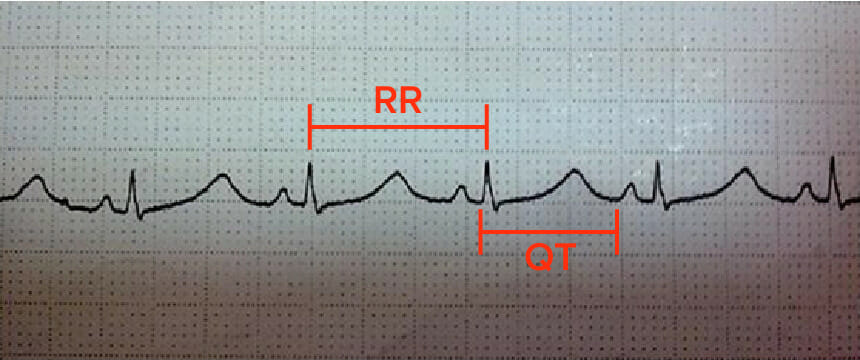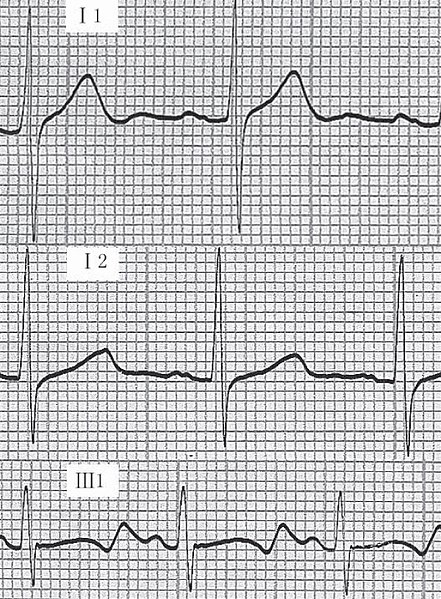Long QT syndrome (LQTS) is a disorder of ventricular myocardial repolarization that produces QT prolongation on electrocardiogram (ECG). Long QT syndrome is associated with an increased risk of developing life-threatening cardiac arrhythmias, specifically torsades de pointes. The condition may be congenital or acquired. Congenital LQTS is attributed to genetic mutations affecting cardiac ion channels. Acquired LQTS usually results from drug therapy or electrolyte abnormalities. Patients can be asymptomatic or present with palpitations, syncope, seizures, and even sudden cardiac death. Diagnosis is established with ECG along with medical and family history, laboratory workup, and other cardiac tests. Treatment is determined by etiology. Acquired LQTS requires removal of the offending drug or drug combinations and correction of electrolyte abnormalities. Congenital LQTS management involves beta blockers, aggressive treatment of electrolyte imbalances, avoidance of medications that prolong the QT interval, and placement of an implantable cardioverter–defibrillator (ICD).
Last updated: Mar 4, 2024

ECG in a patient with long QT syndrome:
The corrected QT interval (QTc) is calculated by dividing the QT interval (0.48 seconds) by the square root of the preceding RR interval (0.825 seconds). In this case, the QTc is 0.582 seconds (582 milliseconds).
Pathophysiology:
Types of congenital Congenital Chorioretinitis LQTS LQTS Long qt syndrome (LQTS) is a disorder of ventricular myocardial repolarization that produces qt prolongation on electrocardiogram (ECG). Long qt syndrome is associated with an increased risk of developing life-threatening cardiac arrhythmias, specifically torsades de pointes. Long QT Syndrome:
Variety of associated conditions:
The diagnosis of long QT syndrome Long QT syndrome Long QT syndrome (LQTS) is a disorder of ventricular myocardial repolarization that produces QT prolongation on electrocardiogram (ECG). Long QT syndrome is associated with an increased risk of developing life-threatening cardiac arrhythmias, specifically torsades de pointes. Long QT Syndrome can be made via an ECG ECG An electrocardiogram (ECG) is a graphic representation of the electrical activity of the heart plotted against time. Adhesive electrodes are affixed to the skin surface allowing measurement of cardiac impulses from many angles. The ECG provides 3-dimensional information about the conduction system of the heart, the myocardium, and other cardiac structures. Electrocardiogram (ECG) of the patient and/or 1st-degree relatives. A careful medication review is indicated for all patients Patients Individuals participating in the health care system for the purpose of receiving therapeutic, diagnostic, or preventive procedures. Clinician–Patient Relationship.

Example of an ECG tracing showing:
i) normal tracing;
ii) Romano-Ward syndrome (prolonged QT);
iii) Jervell-Lange-Nielsen syndrome (prolonged QT).

Example of an ECG tracing showing beat-to-beat axis deviation of the QRS complexes around the baseline. This is known as torsades de pointes or polymorphic ventricular tachycardia.
Image: “Tosadesdepointes” by Panthro. License: Public Domain
Lead II of ECG showing QT prolongation (QTc = 550 ms).
Image: “Lead II of ECG showing QT prolongation” by Department of Pharmacology, Burdwan Medical College, Burdwan, West Bengal 713104, India. License: CC BY 2.0The Schwartz score is used to estimate the likelihood of congenital Congenital Chorioretinitis LQTS LQTS Long qt syndrome (LQTS) is a disorder of ventricular myocardial repolarization that produces qt prolongation on electrocardiogram (ECG). Long qt syndrome is associated with an increased risk of developing life-threatening cardiac arrhythmias, specifically torsades de pointes. Long QT Syndrome.
| Clinical/diagnostics | Findings | Points | |
|---|---|---|---|
| ECGsa | QTc | ≥ 480 msec | 3 |
| 460‒479 msec | 2 | ||
| 450‒459 msec (for males) | 1 | ||
| QTc during recovery from exercise stress testing | ≥ 480 during the 4th minute | 1 | |
| Torsades de pointes Torsades de pointes A malignant form of polymorphic ventricular tachycardia that is characterized by heart rate between 200 and 250 beats per minute, and QRS complexes with changing amplitude and twisting of the points. The term also describes the syndrome of tachycardia with prolonged ventricular repolarization, long qt intervals exceeding 500 milliseconds or bradycardia. Torsades de pointes may be self-limited or may progress to ventricular fibrillation. Ventricular Tachycardia (mutually exclusive) | 2 | ||
| T wave T wave Electrocardiogram (ECG) alternans | 1 | ||
| Notched T wave T wave Electrocardiogram (ECG) in 3 leads | 1 | ||
| ↓ HRb | 0.5 | ||
| Symptoms | Syncope Syncope Syncope is a short-term loss of consciousness and loss of postural stability followed by spontaneous return of consciousness to the previous neurologic baseline without the need for resuscitation. The condition is caused by transient interruption of cerebral blood flow that may be benign or related to a underlying life-threatening condition. Syncope | With stress | 2 |
| Without stress | 1 | ||
| Congenital Congenital Chorioretinitis deafness | 0.5 | ||
| Family history Family History Adult Health Maintenance | Definite LQTS LQTS Long qt syndrome (LQTS) is a disorder of ventricular myocardial repolarization that produces qt prolongation on electrocardiogram (ECG). Long qt syndrome is associated with an increased risk of developing life-threatening cardiac arrhythmias, specifically torsades de pointes. Long QT Syndrome | 1 | |
| Unexplained cardiac death (< 30 years of age)c | 0.5 | ||
The following information is based on US and UK recommendations. Management may vary depending on practice location, so care should be taken to follow local clinical guidelines.
Reduce the risk of fatal arrhythmias:
1st-line medications: beta blockers (BBs)
Subsequent therapies (if unable to tolerate BBs or arrhythmias recur despite their use):
Physical activity after establishing the correct diagnosis:
Treat causes if known:
For torsades de pointes Torsades de pointes A malignant form of polymorphic ventricular tachycardia that is characterized by heart rate between 200 and 250 beats per minute, and QRS complexes with changing amplitude and twisting of the points. The term also describes the syndrome of tachycardia with prolonged ventricular repolarization, long qt intervals exceeding 500 milliseconds or bradycardia. Torsades de pointes may be self-limited or may progress to ventricular fibrillation. Ventricular Tachycardia:
The following medical conditions may predispose individuals to QT prolongation: